Ancient Roman Architecture
Ancient Roman Architecture | Characteristics, Examples, and Facts
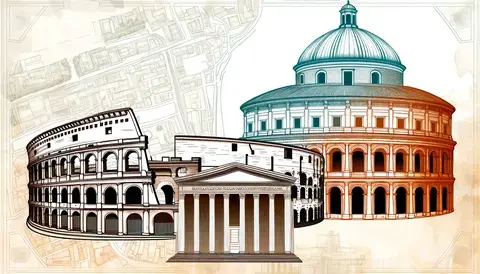
Introduction
Imagine walking through the bustling streets of Rome around 2000 years ago. You would see towering structures like the Colosseum and the Pantheon, buildings that not only showcased the grandeur of the Roman Empire but also embodied revolutionary engineering techniques that are still admired today. These ancient structures continue to influence modern architecture, proving that the Romans were ahead of their time in both design and construction.
Overview:
Ancient Roman architecture is a testament to the innovative spirit and engineering prowess of the Roman Empire. This architectural style, characterized by its grandeur, use of concrete, and incorporation of Greek and Etruscan elements, set the foundation for many architectural practices we see in contemporary times. In this article, we will delve into the historical context, key characteristics, major works, construction techniques, decorative elements, and lasting legacy of ancient Roman architecture. Additionally, we will explore real-life examples and case studies, expert insights, and fun facts to provide a comprehensive understanding of this influential architectural style.
Importance:
Studying ancient Roman architecture is essential for anyone interested in the field of architecture and history. The Romans introduced many architectural innovations, such as the extensive use of arches, vaults, and domes, which have become fundamental elements in building design. Their approach to urban planning, including the creation of extensive road networks and aqueducts, set the standard for city development. Moreover, the aesthetic appeal and functional efficiency of Roman buildings continue to inspire architects and engineers today. By exploring ancient Roman architecture, we gain insights into the cultural, technological, and artistic achievements of one of history's most powerful civilizations.
Historical Context
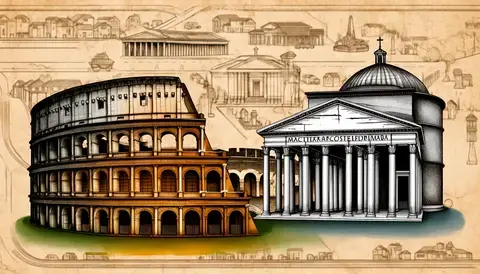
Early Influences
Etruscan Architecture:
- The Etruscans, predecessors to the Romans, greatly influenced early Roman architecture.
- They introduced the arch, which became a fundamental element in Roman construction.
- Etruscan temples, with their deep porches and high podiums, set a precedent for Roman temple design.
Greek Architecture:
- Romans borrowed extensively from Greek architecture, particularly after conquering Greece.
- Greek styles, such as Doric, Ionic, and Corinthian orders, were adapted and incorporated into Roman buildings.
- The Romans took the Greek focus on symmetry and proportions and applied these principles on a grander scale.
Development Timeline
Monarchy (753-509 BCE):
- Founding of Rome traditionally dated to 753 BCE by Romulus.
- Early Roman architecture under the kings was heavily influenced by the Etruscans.
- Key structures from this period include early temples and fortifications.
Republic (509-27 BCE):
- The Roman Republic saw significant advancements in architecture and engineering.
- Construction of major roadways and aqueducts began.
- The use of concrete became more widespread, allowing for more ambitious building projects.
- The Forum Romanum was developed as the political and social heart of the city.
Empire (27 BCE-476 CE):
- Augustus' rise to power marked the beginning of the Roman Empire and a new era in architecture.
- Monumental structures like the Colosseum and the Pantheon were constructed.
- Expansion across Europe, Africa, and Asia brought new materials and influences into Roman architecture.
- Urban planning reached new heights, with cities designed to be functional, beautiful, and reflective of Roman power.
Key Characteristics of Ancient Roman Architecture

Use of Concrete
Development and Advantages:
- Romans developed opus caementicium, a form of concrete that revolutionized construction.
- This material was versatile, durable, and could be molded into various shapes, allowing for innovative designs.
- Concrete enabled the construction of larger and more complex structures compared to stone or brick alone.
Influence on Building Techniques:
- The flexibility of concrete allowed for the creation of vast interior spaces, such as those found in the Pantheon.
- Its use in combination with other materials like brick and stone improved the structural integrity of buildings.
- Concrete's durability meant that many Roman structures have survived for millennia.
Arches and Vaults
Types of Arches:
- Segmental Arch: Utilized in bridges and aqueducts for its ability to span wider gaps.
- Semi-Circular Arch: Common in many Roman buildings, providing both structural support and aesthetic appeal.
- Horseshoe Arch: Less common, but found in some specialized structures and influenced later architectural styles.
Types of Vaults:
- Barrel Vault: Created by extending a single arch along a given distance, forming a continuous tunnel-like structure.
- Groin Vault: Formed by intersecting two barrel vaults at right angles, allowing for the support of large ceilings and creating spacious interiors.
- Ribbed Vault: Developed later in Roman architecture, incorporating ribs for added structural support and aesthetic complexity.
Domes
Pantheon Dome as a Case Study:
- The Pantheon features one of the largest and most impressive domes from ancient Rome.
- Its coffered design reduces the weight of the dome while maintaining structural integrity.
- The oculus at the center provides natural light and reduces the stress on the structure.
Engineering Techniques:
- Use of lightweight materials like pumice in the upper layers of the dome to reduce weight.
- Innovative formwork and scaffolding techniques allowed for the construction of large domes.
- Mastery of the arch principle enabled the distribution of weight evenly across the dome's surface.
Columns and Orders
Doric, Ionic, and Corinthian Orders:
- Doric: Simple, sturdy columns without bases, fluted shafts, and plain capitals.
- Ionic: More slender and elegant columns with bases, fluted shafts, and scrolled capitals.
- Corinthian: Highly ornate columns with acanthus leaves on the capitals, reflecting Greek influence.
Composite and Tuscan Orders:
- Composite: A combination of Ionic and Corinthian elements, with elaborate capitals.
- Tuscan: A simplified version of the Doric order, with unfluted columns and plain capitals, unique to Roman architecture.
Urban Planning
Forum Layout:
- Central open spaces surrounded by important public buildings like temples, basilicas, and government offices.
- Forums served as hubs for political, commercial, and social activities.
Road Systems and Aqueducts:
- Romans developed an extensive network of roads, crucial for military and trade purposes.
- Aqueducts, such as the Aqua Appia and Aqua Claudia, transported water over long distances using gravity, demonstrating advanced engineering skills.
Major Architectural Works
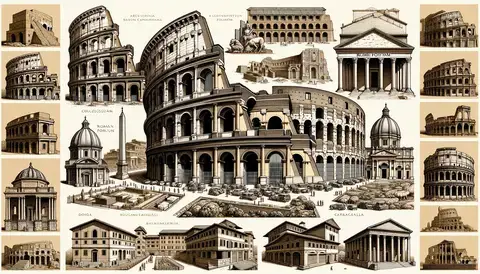
Temples
Pantheon:
- The Pantheon is one of the best-preserved ancient Roman buildings.
- Its massive dome, with a central oculus, remains the largest unreinforced concrete dome in the world.
- The building's portico features Corinthian columns and a triangular pediment, creating a grand entrance.
Temple of Jupiter:
- Located on the Capitoline Hill.
- Known for its massive size and impressive use of the Corinthian order, it was a central religious site in ancient Rome.
Maison Carrée:
- This temple in Nîmes, France, is one of the best-preserved Roman temples.
- Its design follows the classical Roman temple layout with a deep porch and a high podium.
- The Maison Carrée's Corinthian columns and well-preserved structure provide valuable insights into Roman temple architecture.
Public Buildings
Colosseum:
- Also known as the Flavian Amphitheatre, the Colosseum could hold up to 80,000 spectators.
- It was used for gladiatorial contests, public spectacles, and mock sea battles.
- The structure features multiple levels of arches and a complex system of vaults, illustrating Roman engineering prowess.
Roman Forum:
- The political, commercial, and social heart of ancient Rome, the Forum hosted public speeches, criminal trials, and gladiatorial matches.
- Key buildings include the Senate House (Curia), the Rostra (speaker's platform), and various temples and basilicas.
- The Forum's layout and structures demonstrate the Romans' urban planning and architectural skills.
Baths of Caracalla:
- These public baths were among the largest and most impressive bathing complexes in ancient Rome.
- The complex included hot and cold baths, a gymnasium, libraries, and gardens.
- The baths' massive vaulted ceilings and extensive use of mosaics and sculptures highlight the grandeur of Roman public architecture.
Residential Architecture
Domus:
- A domus was a private residence for wealthy Romans, typically one or two stories high.
- Key features included an atrium (central courtyard), peristyle (garden), and various rooms for family and guests.
- The domus was designed to be both functional and luxurious, often decorated with frescoes and mosaics.
Insulae:
- Insulae were multi-story apartment buildings that housed the majority of Rome's urban population.
- These buildings were typically made of brick and concrete, with shops on the ground floor and apartments above.
- Insulae varied in quality, with wealthier residents occupying the lower floors and poorer residents the upper floors.
Villas:
- Roman villas were country homes for the wealthy, serving as both residences and centers of agricultural production.
- Villas were often lavishly decorated and included extensive gardens, baths, and outbuildings for farming activities.
- Examples of Roman villas, such as the Villa of the Mysteries in Pompeii, showcase the luxurious lifestyle of the Roman elite.
Construction Techniques and Materials

Materials
Concrete:
- Roman concrete, known as opus caementicium, was a revolutionary building material composed of lime mortar, volcanic ash, and aggregate.
- Its durability and versatility allowed for the construction of large and complex structures, such as the Pantheon and the Colosseum.
- The use of concrete enabled the Romans to create more flexible and innovative architectural designs.
Stone:
- Marble: Widely used for its beauty and durability, marble was employed in temples, public buildings, and monuments. Famous quarries, like those in Carrara, supplied high-quality marble.
- Travertine: A form of limestone, travertine was commonly used for building facades, amphitheaters, and bath complexes due to its strength and ease of working.
- Tuff: This volcanic rock was used for foundations and walls, especially in the early periods of Roman construction.
Brick:
- Romans developed advanced brick-making techniques, producing standardized, kiln-fired bricks.
- Brick was often used in conjunction with concrete to construct walls, arches, and vaults, then faced with stone or stucco for aesthetic purposes.
- Brick structures, such as those found in Ostia Antica, demonstrate the durability and versatility of Roman brickwork.
Techniques
Roman Brickwork:
- Opus Latericium: Consisted of regular, rectangular bricks laid in horizontal courses, often used for walls and vaults.
- Opus Reticulatum: Featured a diamond-shaped pattern of tuff or brick stones set into a concrete core, creating a visually appealing and structurally sound surface.
- Opus Testaceum: Used triangular bricks with their pointed ends set into the concrete core, leaving a flat surface exposed, often used for exterior walls.
Opus Caementicium:
- A technique involving the pouring of concrete into wooden frames, which could be molded into various shapes, enabling the construction of complex forms like domes and vaults.
- The addition of pozzolana, a type of volcanic ash, improved the concrete's strength and durability, making it a key component in Roman construction.
Opus Reticulatum:
- A technique involving the use of small, pyramid-shaped stones set in a diagonal pattern within a concrete wall.
- This method created a distinctive, grid-like appearance and provided both structural stability and decorative appeal.
Opus Testaceum:
- A method using flat, triangular bricks embedded into the concrete core, with their pointed ends set into the wall and the flat sides exposed.
- This technique provided a smooth, finished surface and was often used for exterior walls and facades.
Decorative Elements
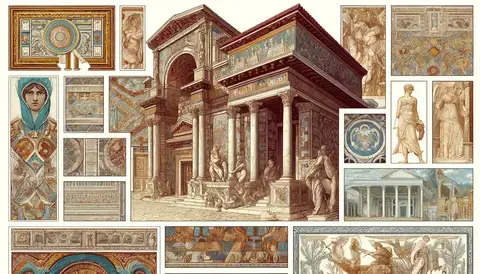
Mosaics
Techniques and Materials:
- Roman mosaics were created using small pieces of colored stone, glass, or ceramic called tesserae.
- Artists meticulously arranged tesserae to create intricate patterns and detailed images on floors, walls, and ceilings.
- Common themes included geometric designs, mythological scenes, and depictions of daily life.
Examples from Pompeii and Herculaneum:
- The House of the Faun in Pompeii features a famous mosaic of Alexander the Great's battle.
- Mosaics in Herculaneum depict scenes of marine life showcasing the artistry and creativity of Roman mosaicists.
- Both sites provide valuable insights into the aesthetic preferences and social customs of ancient Romans.
Frescoes
Styles and Techniques:
- Roman frescoes were created by applying pigment to wet plaster, allowing the colors to bond with the wall surface.
- The four Pompeian styles of fresco painting evolved from simple imitations of marble panels to complex, detailed compositions.
- Common subjects included landscapes, portraits, mythological themes, and architectural vistas.
Famous Examples:
- The Villa of the Mysteries in Pompeii contains elaborate frescoes depicting Dionysian rituals.
- The House of the Vettii features a variety of frescoes, including detailed mythological scenes and intricate architectural perspectives.
- These frescoes highlight the Romans' appreciation for art and their desire to adorn their homes with visually stunning imagery.
Sculptures
Integration with Architecture:
- Roman sculptures often adorned public buildings, temples, and private residences, serving both decorative and functional purposes.
- Statues of emperors, and notable figures were commonly placed in niches, courtyards, and gardens.
- Relief sculptures decorated triumphal arches, columns, and altars, narrating historical events and mythological tales.
Notable Works:
- The Ara Pacis Augustae (Altar of Augustan Peace) features intricate reliefs depicting Augustus and his family, symbolizing peace and prosperity.
- The Arch of Titus in Rome displays reliefs of the Roman victory over Jerusalem, celebrating the emperor's triumph.
- Portrait busts of emperors, like those of Augustus and Hadrian, exemplify the Roman skill in capturing realistic and idealized likenesses.
Influence and Legacy
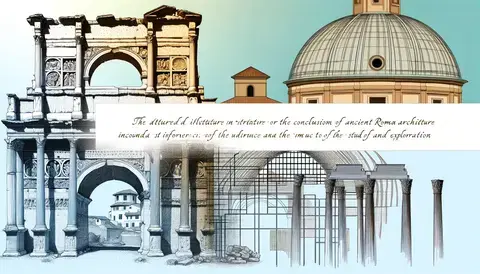
Influence on Later Periods
Renaissance Architecture:
- The Renaissance saw a revival of classical principles, heavily influenced by Roman architecture.
- Architects like Filippo Brunelleschi and Andrea Palladio studied Roman ruins to inspire their designs.
- Key elements such as domes, arches, and the use of classical orders were reinterpreted in Renaissance buildings.
Neoclassical Architecture:
- Neoclassicism emerged in the 18th century as a reaction to the ornate Baroque style, drawing directly from Roman architecture.
- Prominent structures, including the United States Capitol and the British Museum, showcase Roman-inspired elements like columns, pediments, and domes.
- The movement emphasized symmetry, simplicity, and grandeur, echoing the principles of ancient Roman design.
Modern Examples
Influence on Public Buildings:
- Many modern public buildings, such as capitols, courthouses, and museums, incorporate Roman architectural elements.
- These buildings often feature grand facades with columns, extensive use of arches, and domes, reflecting the grandeur and formality of Roman structures.
- The use of Roman-inspired architecture in civic buildings conveys a sense of authority, stability, and cultural heritage.
Examples in Contemporary Architecture:
- Contemporary architects continue to draw inspiration from Roman design principles, integrating them with modern materials and technologies.
- Buildings like the Getty Center in Los Angeles and the Reichstag Dome in Berlin incorporate Roman elements such as courtyards, columns, and vaulted spaces, adapted to contemporary aesthetics and functions.
- The blending of ancient Roman architectural techniques with modern design demonstrates the timeless appeal and versatility of Roman innovations.
Real-Life Examples and Case Studies

Colosseum Restoration
Modern Efforts to Preserve:
- The Colosseum has undergone several restoration projects to address damage from natural disasters, pollution, and wear over centuries.
- Modern techniques, including the use of laser cleaning and advanced materials, help preserve the structure while maintaining its historical integrity.
- Recent restorations have focused on stabilizing the outer walls, restoring the underground hypogeum, and improving accessibility for visitors.
Techniques Used:
- Structural reinforcements using stainless steel and advanced polymers provide stability without altering the Colosseum's appearance.
- Laser cleaning removes grime and biological growth from the stone surfaces, revealing the original texture and color.
- 3D scanning and digital modeling assist in planning restorations and monitoring the structure's condition over time.
Pompeii and Herculaneum
Excavations and Discoveries:
- The ancient cities of Pompeii and Herculaneum were buried by the eruption of Mount Vesuvius in 79 CE, preserving a snapshot of Roman life.
- Excavations began in the 18th century and continue to this day, revealing homes, public buildings, frescoes, and everyday artifacts.
- Significant discoveries include well-preserved frescoes, mosaics, and household items that provide insights into Roman daily life and artistic practices.
Impact on Understanding Roman Daily Life:
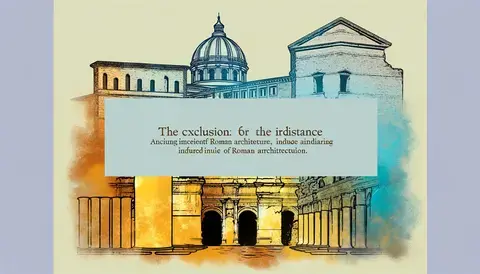
- The excavated sites offer a detailed view of Roman urban planning, residential architecture, and social customs.
- Artefacts such as tools, pottery, and personal items reveal the daily activities and lifestyles of ancient Romans.
- The preservation of organic materials, including food remains and wooden furniture, provides unique insights into the diet and domestic practices of the time.
Expert Quotes and Insights
Quotes from Historians and Architects
Perspectives on Roman Engineering:
- “The ingenuity of Roman engineering lies in their ability to combine functionality with grandeur, creating structures that are not only impressive but also enduring.” – Dr. Marcus Evans, Historian.
- “Roman use of concrete and the development of the arch and vault transformed architecture, allowing for the construction of vast interior spaces that were previously unimaginable.” – Prof. Julia Thomson, Architect.
Thoughts on Aesthetic Impact:
- “The aesthetic appeal of Roman architecture comes from its harmonious proportions, intricate details, and the seamless integration of art and engineering.” – Dr. Laura Simmons, Art Historian.
- “Roman buildings, with their columns, domes, and arches, continue to inspire modern architects, demonstrating the timeless beauty and utility of classical design.” – Architect Michael Collins.
Interviews with Modern Architects
How Ancient Roman Techniques Are Applied Today:
- Modern architects often draw inspiration from Roman designs when creating public buildings, incorporating elements like arches and columns to convey stability and grandeur.
- “The principles of Roman urban planning, such as the use of open public spaces and efficient infrastructure, are still relevant in contemporary city planning.” – Urban Planner Sarah Brown.
- “Innovations in building materials and techniques today build upon the foundational work of Roman engineers, allowing us to create even more ambitious structures while maintaining aesthetic appeal.” – Architect David Lee.
Fun Facts
Little-Known Tidbits
Secret Passages in the Colosseum:
- The Colosseum contained a complex network of underground tunnels and chambers, known as the hypogeum, used to house gladiators, animals, and stage equipment.
- These secret passages allowed for dramatic and unexpected entrances during games and spectacles.
Unique Uses of Roman Buildings:
- The Pantheon, originally a temple for all Roman gods, was converted into a Christian church in the 7th century, which helped preserve it through the ages.
- Many Roman structures were repurposed over time, with some temples being transformed into churches, fortresses, or public buildings.
Myth Busting
Common Misconceptions about Roman Architecture:
- Contrary to popular belief, not all Roman buildings were white marble; many were brightly painted and decorated with colorful frescoes and mosaics.
- The idea that the Romans only borrowed architectural ideas from the Greeks is incorrect. While influenced by Greek architecture, the Romans innovated and developed their own unique styles and techniques.
Key Takeaways
Summary of Main Points
Recap Key Characteristics:
- Ancient Roman architecture is characterized by its use of concrete, arches, vaults, domes, and columns.
- The Romans developed advanced construction techniques and materials, enabling the creation of large and complex structures.
Highlight Significant Examples:
- Iconic buildings such as the Colosseum, Pantheon, and Roman Forum illustrate the grandeur and innovation of Roman architecture.
- Residential architecture, including domus, insulae, and villas, showcases the diversity and functionality of Roman homes.
Importance of Roman Architecture
Lasting Legacy:
- The influence of Roman architecture is evident in Renaissance, Neoclassical, and modern designs, demonstrating its timeless appeal and relevance.
- Studying Roman architecture provides valuable insights into the cultural, technological, and artistic achievements of one of history's most powerful civilizations.
Further Exploration
Recommended Books and Articles
Essential Readings:
- "Roman Architecture" by Frank Sear: A comprehensive guide to the development and significance of Roman architectural innovations.
- "The Pantheon: From Antiquity to the Present" by Tod A. Marder and Mark Wilson Jones: An in-depth exploration of one of Rome's most iconic structures.
- "Pompeii: The Life of a Roman Town" by Mary Beard: An engaging account of daily life in Pompeii, with insights into its architecture.
Articles and Journals:
- "The Engineering Marvels of Ancient Rome" in Engineering Rome: An article detailing the technological achievements of Roman engineers.
Educational Websites:
- Khan Academy: Ancient Rome: Offers video lessons and articles on Roman history and architecture.
Conclusion
Reflective Thoughts
The Enduring Relevance of Roman Architecture: Ancient Roman architecture continues to be a source of inspiration and admiration in the modern world. The innovative use of materials, structural ingenuity, and aesthetic appeal of Roman buildings have left an indelible mark on architectural history. From grand public buildings to residential homes, the principles established by Roman architects have been adapted and reinterpreted through the centuries, demonstrating the timelessness of their designs.
Call to Action
The study of Ancient Roman architecture offers valuable insights into the cultural, technological, and artistic achievements of one of history's most influential civilizations. By exploring Roman architectural practices, we can gain a deeper appreciation for the foundations of modern architecture. We encourage you to delve further into this fascinating subject, visit historical sites, read extensively, and engage with educational resources to enhance your understanding and appreciation of Roman architectural legacy.
